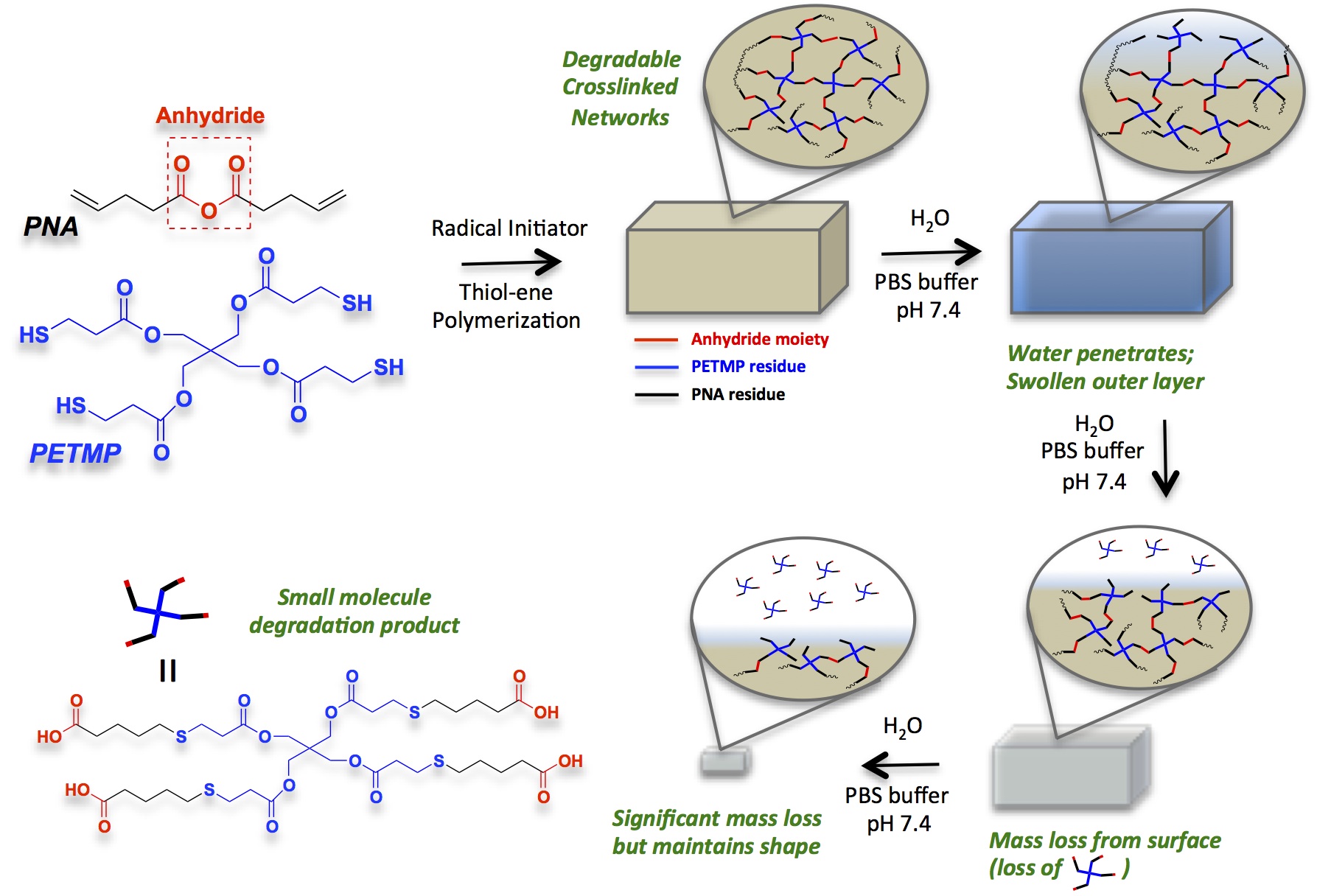Introduction: Polyanhydrides have long been known as surface-eroding biomaterials, and thus have realized their potential in drug-release devices such as the Gliadel Wafer™. However, despite extensive efforts there have been several significant roadblocks to the further application of these materials in the biomedical arena. One of the primary problems is the demanding curing process of the monomers used in the majority of studies since these monomers are often diacids (or their acyl chloride derivatives). Therefore, such reactions need high vacuum and temperatures, rendering in situ curing impossible. We have recently[1][2] shown that thiol-ene radical polymerization is ideally suited for the polymerization of polyanhydrides (Scheme 1). Here we discuss the synthesis, characterization and erosion characteristics of these materials.

Materials: 4-Pentenoic anhydride (PNA), 1,6-hexanedithiol (HDT), pentaerythritol tetrakis(3-mercaptopropionate) (PETMP), 1-hydroxycyclohexyl phenyl ketone were purchased from Sigma-Aldrich.
Methods: Example synthesis using PNA:HDT:PETMP = 100:70:30 (mole ratios of functional groups): 1-hydroxycyclohexyl phenyl ketone (1.4 mg, 0.0069 mmol, 0.1 wt%), PETMP (0.22 mL, 0.57 mmol), HDT (0.41 mL, 2.68 mmol) and PNA (0.7 mL, 3.83 mmol) were weighed into a small vial. After mixing to establish a homogenous solution it was transferred to a mold for polymerization and irradiated by UV light for 15 minutes. Samples were degraded by placing them into 100 mL of aqueous PBS solution at 37°C. At select time intervals, the polymer was removed from the buffered solution, the surface quickly dried and polymer weighed and new buffer solution added.
Results: Thiol-ene polymerizations were photoinitiated using to yield crosslinked polyanhydrides with essentially 100% conversion of thiol and ene groups. The inclusion of HDT at amounts of >60% thiol groups (but <100%) yielded semicrystalline crosslinked polyanhydrides, as determined by differential scanning calorimetry (DSC), which showed crystalline melt temperatures of approximately 60oC, and wide-angle x-ray diffraction. Erosion of these materials showed qualitative surface erosion behavior; with mass-loss curves exhibiting a short induction period (~24 hours) before erosion being compete in around 10 days (Figure 1).

Discussion: In comparison with traditional approaches to polyanhydride synthesis, thiol-ene ‘click’ chemistry has many advantages: many monomers are simple and readily available, and there is low susceptibility to oxygen, low shrinkage, and uniform cross-link density. Furthermore, because thiol-ene polymerization occurs via a step-growth mechanism, the degradable anhydride functionality resides in the main chain, rather than a side chain, which reduces the molecular weight of the degradation products compared to biomaterials synthesized by chain growth polymerizations. Initiation can be achieved using purely thermal, redox, or photochemical methods, or some combination of these. We have also found that surface erosion occurs, [1][3] and the materials have very high cytocompatibility, even at elevated concentrations [2][4].
Conclusions: Thiol-ene chemistry can be reliably applied to the rapid production of polyanhydrides that are surface-eroding in aqueous environments, and presents significant opportunities for potentially broad use of these materials in many applications, including biomedical devices, adaptable surfaces, shape memory materials, drug delivery, erodible/resorbable adhesives, self-cleaning surfaces, adaptable and patternable surfaces, functionalized surfaces/particles, hierarchical structures, and scaffolds for cell growth.
References:
[1] D. A. Shipp, C. W. McQuinn, B. G. Rutherglen, R. A. McBath, Chem. Commun. 2009, 6415-6417.
[2] K.L. Poetz, H. S. Mohammed, D. A. Shipp, Biomacromolecules, 2015, 16,1650-1659.
[3] S. Domanskyi, K. L. Poetz, D. A. Shipp, Vladimir Privman, Phys. Chem. Chem. Phys., 2015, 17, 13215-13222.
[4] K.L. Poetz, H. S. Mohammed, B. L. Snyder, G. Liddil, D. S. K. Samways, D. A. Shipp, Biomacromolecules, 2014, 15, 2573-2582.